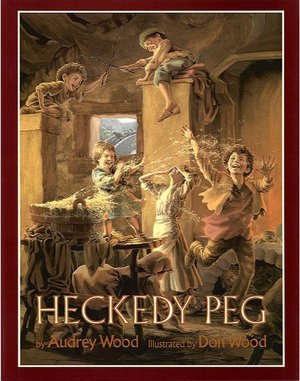Of course, on Wednesday night, I decided that I was hot and sweaty already--might as well go pick raspberries and flowers! The end result was a gorgeous bouquet, four pints of fresh berries to give to colleagues, and two big containers of jam.
In school this week I've worked hard to get kids working on independent reading, just like I do every fall. I'm glad that I wrote these lesson plans several years ago--I still print them and follow them each year! The start of the school year is overwhelming enough without starting from scratch.
The path to independent reading starts with read alouds. During read aloud, I can model the kinds of thinking that I'm expecting of students during independent reading. Over the course of this week, students slowly took over the task of thinking about our shared texts.
Tuesday: Students shared their thinking with a partner. I generalized the kind of thinking from what they shared ("You shared a question. Questioning is a kind of thinking that readers do.") and made a chart.
Wednesday: Students wrote their thinking on two sticky notes when I stopped at two points in the text. They shared their thinking with a partner, and we tried to categorize their thinking. ("When you make a guess about how a character is feeling, that's a kind of thinking called inferring.")
Thursday: Students wrote their thinking on two sticky notes about our read aloud, and then two sticky notes from independent reading. They tried to categorize their thinking and wrote symbols like question marks, exclamation points, or stars to represent different kinds of thinking.
Friday: Students graduated to putting their thinking on a chart that they will use over the next few weeks.
But what books do I choose to start the year? I like to change things up. One thing that I wanted to do this year was give kids a taste of books that are not easy, and that do not yield their secrets quickly. But this is not always successful when kids are hot and sweaty. So I had to be very careful in my book picks, probably more careful than those lucky teachers in chilly buildings.
Instructions by Neil Gaiman turned out to be a good choice. I spent most of last summer devouring Neil Gaiman's books for adults, so when I ran into this in a beachside bookstore I knew I had to have it. It's interesting enough to keep kids entranced, and short enough to read in just a few moments. But it leaves a reader with more questions than answers. In case you haven't read it, the book is a poetic set of instructions for a quest, shown acted out by a fox. It looks like a fairy tale, reads like procedural text, and leaves you thinking.
Previously by Allan Ahlberg turned out to be loved by some, hated by others. Perfect for teaching about reading ratings! (Hm, can you tell that I read a lot of British fantasy over the summer? Like dark chocolate, it's left a taste in my mouth.) This story upends fairy tales by telling what happened--well, previously. Never before have I thought that the Jack who fought the giant was the same Jack that fell down the hill! The students liked the illustrations, especially the endpiece that shows the characters as babies.
My computer has broken recently. I knew it was going to happen, so luckily I made backups of everything. In going through my files, I found old, old files and felt a bit of nostalgia for things that I haven't done in a long time. This led me to choose Heckedy Peg, a used bookstore find, as a read aloud. I first met this book when I was teaching a 4 year-old preschool class long ago. The center director was a fabulous teacher who sometimes read this book to the students before naptime while I cleaned up from lunch and set out cots. While some might not want to share a book with a scary witch in it with young children, this director knew that kids need fairy tales and an element of danger. Besides, Heckedy Peg stars a wonderful mother who bravely and cleverly gets her children back. It was a big naptime hit.
Would fourth graders enjoy this as much as preschoolers? Absolutely! They all wanted to read it again during independent reading time. One boy asked to take it home for the weekend to read to his mother. From a teaching standpoint, I love how an event in the beginning of the book (what the children want their mother to bring home from the market) leads to the resolution of the conflict at the end of the book. Many traditional fairy tales just don't hang together this well.
I have written about Crab Moon before. I love the paintings in this book. For teaching about narrative and informational text, this book is a must. It has information in it, but is still definitely a narrative. This leads to a great discussion with students about the differences between narrative and informational text.
Crab Moon also helped me to learn some important information about my readers. After the main character, Daniel, helps a horseshoe crab, he grins. I asked the students, "How do you think Daniel feels on this page?" They shared their thinking with partners, and then several shared with the whole class. The consensus was that Daniel felt "happy" (proud did not make an appearance). Despite repeatedly asking, "What in the text might makes you think this?" and rereading the last paragraph on the page, I couldn't get any student to refer to the fact that Daniel grins to support their inferences. (And I feel that I can only go so far with leading questions. If the skill isn't there, it's not there, and dragging it out of kids isn't going to solve anything.) So I know that my work is cut out for me as far as supporting inferences with evidence from text. I'll start with this in small group reading sessions next week, using texts that support text-based inferences.
After we read the book together, I shared my own pictures of horseshoe crabs. These led to more talking and questioning and led several students to choose the informational books about horseshoe crabs that just happened to be prominently displayed. This is the beginning of matching details from different texts, which in turn is the beginning of becoming an expert...so big things were happening.
So it's been a productive week. In between reading times we have done tons of screening assessments. While these numbers are useful, I really think that the time we share in read aloud tells me just as much about what this year's classes will be like. I'm looking forward to getting to know all of the readers even better!







So sorry you have to suffer through the heat. I have been there and done that. Our district just finished this past year air conditioning every building. I've been lucky enough to be in an air conditioned one for the last 4 years. Love your ideas you share, as always. Going to check into these books. They sound great.
ReplyDelete